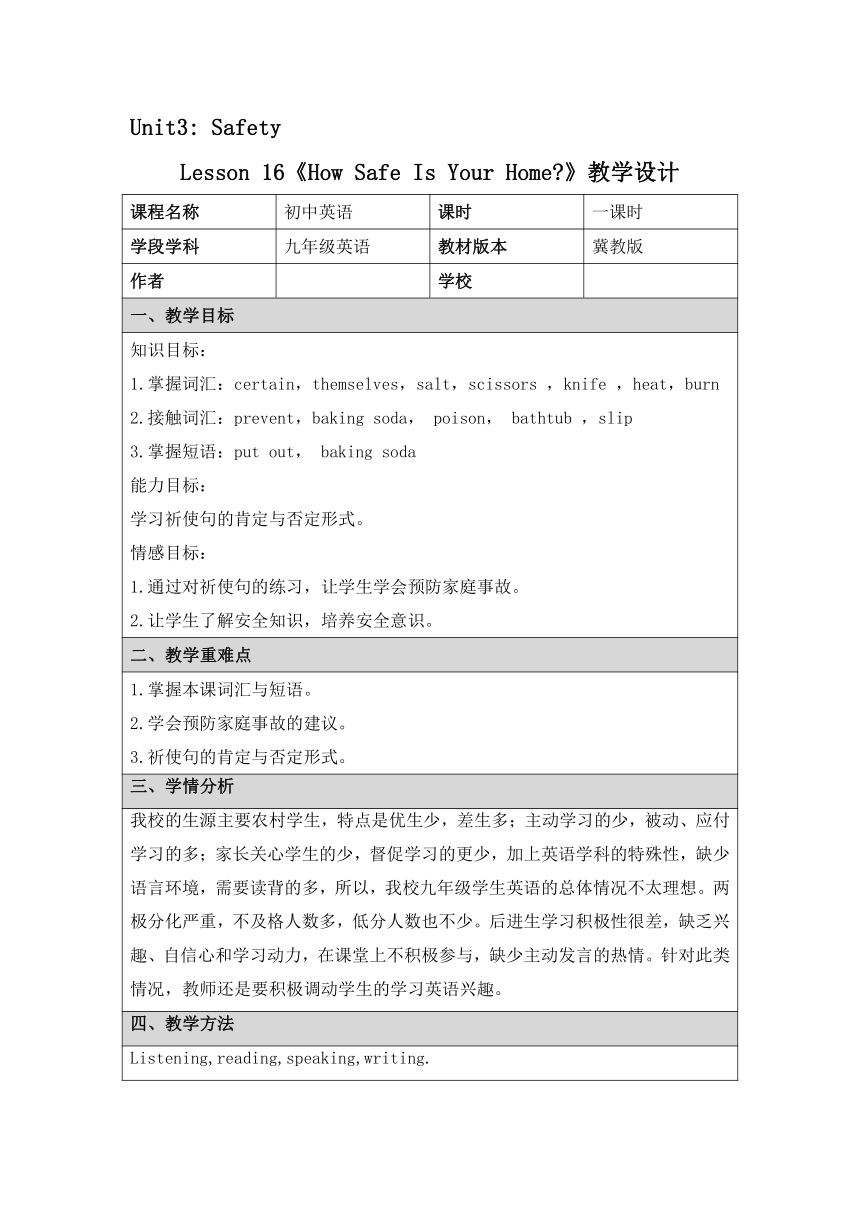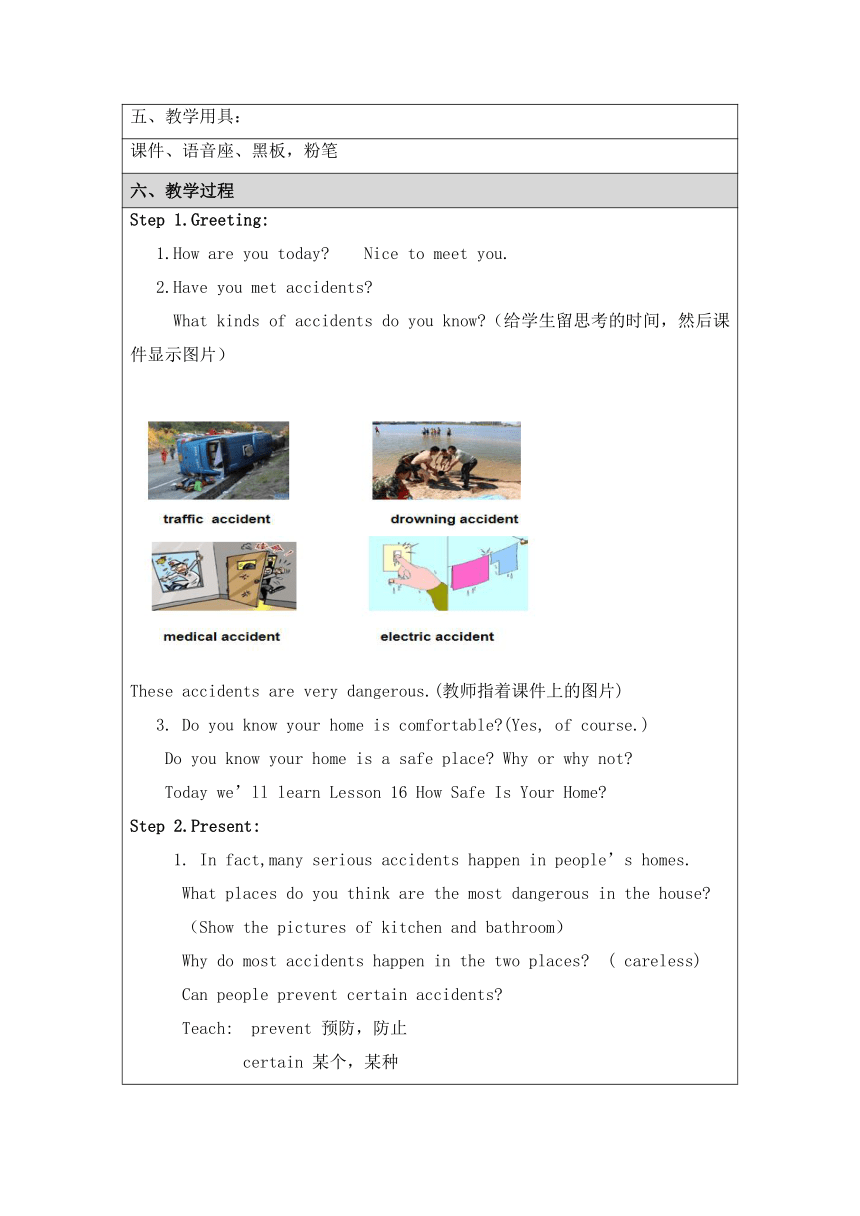冀教版九年级How Safe Is Your Home教学设计(表格式)
文档属性
| 名称 | 冀教版九年级How Safe Is Your Home教学设计(表格式) |  | |
| 格式 | docx | ||
| 文件大小 | 544.8KB | ||
| 资源类型 | 教案 | ||
| 版本资源 | 冀教版 | ||
| 科目 | 英语 | ||
| 更新时间 | 2022-07-27 21:04:59 | ||
图片预览



文档简介
Unit3: Safety
Lesson 16《How Safe Is Your Home 》教学设计
课程名称 初中英语 课时 一课时
学段学科 九年级英语 教材版本 冀教版
作者 学校
一、教学目标
知识目标: 掌握词汇:certain,themselves,salt,scissors ,knife ,heat,burn 接触词汇:prevent,baking soda, poison, bathtub ,slip 掌握短语:put out, baking soda 能力目标: 学习祈使句的肯定与否定形式。 情感目标: 1.通过对祈使句的练习,让学生学会预防家庭事故。 2.让学生了解安全知识,培养安全意识。
二、教学重难点
掌握本课词汇与短语。 学会预防家庭事故的建议。 3.祈使句的肯定与否定形式。
三、学情分析
我校的生源主要农村学生,特点是优生少,差生多;主动学习的少,被动、应付学习的多;家长关心学生的少,督促学习的更少,加上英语学科的特殊性,缺少语言环境,需要读背的多,所以,我校九年级学生英语的总体情况不太理想。两极分化严重,不及格人数多,低分人数也不少。后进生学习积极性很差,缺乏兴趣、自信心和学习动力,在课堂上不积极参与,缺少主动发言的热情。针对此类情况,教师还是要积极调动学生的学习英语兴趣。
四、教学方法
Listening,reading,speaking,writing.
五、教学用具:
课件、语音座、黑板,粉笔
六、教学过程
Step 1.Greeting: 1.How are you today Nice to meet you. 2.Have you met accidents What kinds of accidents do you know (给学生留思考的时间,然后课件显示图片) These accidents are very dangerous.(教师指着课件上的图片) 3. Do you know your home is comfortable (Yes, of course.) Do you know your home is a safe place Why or why not Today we’ll learn Lesson 16 How Safe Is Your Home Step 2.Present: 1. In fact,many serious accidents happen in people’s homes. What places do you think are the most dangerous in the house (Show the pictures of kitchen and bathroom) Why do most accidents happen in the two places ( careless) Can people prevent certain accidents Teach: prevent 预防,防止 certain 某个,某种 2.Today let’s learn some safety tips for preventing accidents in the kitchen and bathroom. Show accident pictures in the kitchen. Picture 1: what is the boy doing What will happen What should we say to the boy ( Don’t stand on chairs.) Picture 2: What happened ( The kitchen is on fire.) What is the man doing ( He is using water to put out the fire.) Teach: put out 扑灭 Is it the right way to put out the fire What should we say to the man ( Don’t use water to put out fires. Use baking soda or salt instead)Teach: baking soda 、 salt Picture 3: What can you see Teach: knife (knives) scissors If we use the scissors and knives carelessly,What will happen (Many people cut themselves in the kitchen.) Teach: themselves What should we do (Be careful with scissors and knives.) Teach: be careful with Picture 4: What’s this Teach: poison Can we put them in the kitchen What should we do (Don’t keep poisons in the kitchen.) Picture 5: What can you see ( fire stove heat ) Teach : heat If you are careless, what will happen (It will burn yourself. ) Teach : burn 烧伤,烫伤,燃烧 burn- burnt/burned-burnt/burned What should we do ( Be careful with fire and heat when you cook.) Show accident pictures in the bathroom. Picture 1: What can you see Teach : bathtub Can we leave the small children alone in the bathtub What should we do ( Never leave small children alone in a bathtub. Never use electricity in the shower and bathtub ) Picture 2 : What happened ( The old woman slipped.) Teach : slip Why ( The floor is wet) What should we do (Be sure to keep the bathroom floor dry, or it’s easy to slip.) Teach : be sure to do sth. Step 3. Imperatives Show these sentences on the screen. Use baking soda or salt instead. Be careful with scissors and knives. Be careful with fire and heat. Be sure to keep the bathroom floor dry.
These are positive sentences. We use the room form of the verb at the beginning of the sentence . 2 . Show these sentences on the screen。 Don’t stand on chairs. Don’t use water to put out fires. Don’t keep poisons in the kitchen. Don’t put some things near the stove. Never leave small children alone in a bathtub. Never use electricity in the shower and bathtub.
These are negative sentences. Don’t + verb Never + verb There is another way of negative sentence.No + Noun./v.ing No smoking. No parking. No photos.
Step 4: Listen Play the audiotape for Lesson 16 .Answer the question : How many safety tips are there in the kitchen/bathroom Step 5: Read 1. Read the lesson and complete Exercise 1in groups.Then ask a few students to write the answers on the blackboard. Safety tips for preventing accidents in the kitchen.Safety tips for preventing accidents in the bathroom.DosDon’tsDos Don’ts
2. Practice reading the lesson.Then divide the lesson into three parts.Ask three students to read the lesson. Step 6: Additional activities. Show six pictures on the screen. Use imperatives to make sentences. Students discuss and complete. Answers: Don’t play football on the street. Never take the knife to school. Help mum do the housework. No smoking. Don’t draw on the wall. Please be quiet.
Step 7: Summary: 1. The words and the phrases. 2.The imperatives: Do/Be.... Don’t do... Never do.. NO.... Step 8: Homework: Write a passage about the safety tips in the kitchen and bathroom. Step 9: Blackboard design: Lesson 16 How Safe Is Your Home Prevent certain Put out baking soda Salt knife---knives Scissors poison Burn heat Bathtub slip Be sure to do sth. 祈使句 肯定句: Do/Be... 否定句: Don’t do... Never do.. NO ...
教学反思: 本课学习厨房与浴室的安全常识,让学生增强安全意识。本课采用了多媒体教学,直观性强,学生易懂、感兴趣,课堂效果良好。在此总结了祈使句的肯定形式与否定形式的用法,通过拓展练习,大多数学生已经掌握了本课内容。通过课后作业反馈,有个别基础差的学生在祈使句中找不到动词,今后还要多辅导学困生。
Lesson 16《How Safe Is Your Home 》教学设计
课程名称 初中英语 课时 一课时
学段学科 九年级英语 教材版本 冀教版
作者 学校
一、教学目标
知识目标: 掌握词汇:certain,themselves,salt,scissors ,knife ,heat,burn 接触词汇:prevent,baking soda, poison, bathtub ,slip 掌握短语:put out, baking soda 能力目标: 学习祈使句的肯定与否定形式。 情感目标: 1.通过对祈使句的练习,让学生学会预防家庭事故。 2.让学生了解安全知识,培养安全意识。
二、教学重难点
掌握本课词汇与短语。 学会预防家庭事故的建议。 3.祈使句的肯定与否定形式。
三、学情分析
我校的生源主要农村学生,特点是优生少,差生多;主动学习的少,被动、应付学习的多;家长关心学生的少,督促学习的更少,加上英语学科的特殊性,缺少语言环境,需要读背的多,所以,我校九年级学生英语的总体情况不太理想。两极分化严重,不及格人数多,低分人数也不少。后进生学习积极性很差,缺乏兴趣、自信心和学习动力,在课堂上不积极参与,缺少主动发言的热情。针对此类情况,教师还是要积极调动学生的学习英语兴趣。
四、教学方法
Listening,reading,speaking,writing.
五、教学用具:
课件、语音座、黑板,粉笔
六、教学过程
Step 1.Greeting: 1.How are you today Nice to meet you. 2.Have you met accidents What kinds of accidents do you know (给学生留思考的时间,然后课件显示图片) These accidents are very dangerous.(教师指着课件上的图片) 3. Do you know your home is comfortable (Yes, of course.) Do you know your home is a safe place Why or why not Today we’ll learn Lesson 16 How Safe Is Your Home Step 2.Present: 1. In fact,many serious accidents happen in people’s homes. What places do you think are the most dangerous in the house (Show the pictures of kitchen and bathroom) Why do most accidents happen in the two places ( careless) Can people prevent certain accidents Teach: prevent 预防,防止 certain 某个,某种 2.Today let’s learn some safety tips for preventing accidents in the kitchen and bathroom. Show accident pictures in the kitchen. Picture 1: what is the boy doing What will happen What should we say to the boy ( Don’t stand on chairs.) Picture 2: What happened ( The kitchen is on fire.) What is the man doing ( He is using water to put out the fire.) Teach: put out 扑灭 Is it the right way to put out the fire What should we say to the man ( Don’t use water to put out fires. Use baking soda or salt instead)Teach: baking soda 、 salt Picture 3: What can you see Teach: knife (knives) scissors If we use the scissors and knives carelessly,What will happen (Many people cut themselves in the kitchen.) Teach: themselves What should we do (Be careful with scissors and knives.) Teach: be careful with Picture 4: What’s this Teach: poison Can we put them in the kitchen What should we do (Don’t keep poisons in the kitchen.) Picture 5: What can you see ( fire stove heat ) Teach : heat If you are careless, what will happen (It will burn yourself. ) Teach : burn 烧伤,烫伤,燃烧 burn- burnt/burned-burnt/burned What should we do ( Be careful with fire and heat when you cook.) Show accident pictures in the bathroom. Picture 1: What can you see Teach : bathtub Can we leave the small children alone in the bathtub What should we do ( Never leave small children alone in a bathtub. Never use electricity in the shower and bathtub ) Picture 2 : What happened ( The old woman slipped.) Teach : slip Why ( The floor is wet) What should we do (Be sure to keep the bathroom floor dry, or it’s easy to slip.) Teach : be sure to do sth. Step 3. Imperatives Show these sentences on the screen. Use baking soda or salt instead. Be careful with scissors and knives. Be careful with fire and heat. Be sure to keep the bathroom floor dry.
These are positive sentences. We use the room form of the verb at the beginning of the sentence . 2 . Show these sentences on the screen。 Don’t stand on chairs. Don’t use water to put out fires. Don’t keep poisons in the kitchen. Don’t put some things near the stove. Never leave small children alone in a bathtub. Never use electricity in the shower and bathtub.
These are negative sentences. Don’t + verb Never + verb There is another way of negative sentence.No + Noun./v.ing No smoking. No parking. No photos.
Step 4: Listen Play the audiotape for Lesson 16 .Answer the question : How many safety tips are there in the kitchen/bathroom Step 5: Read 1. Read the lesson and complete Exercise 1in groups.Then ask a few students to write the answers on the blackboard. Safety tips for preventing accidents in the kitchen.Safety tips for preventing accidents in the bathroom.DosDon’tsDos Don’ts
2. Practice reading the lesson.Then divide the lesson into three parts.Ask three students to read the lesson. Step 6: Additional activities. Show six pictures on the screen. Use imperatives to make sentences. Students discuss and complete. Answers: Don’t play football on the street. Never take the knife to school. Help mum do the housework. No smoking. Don’t draw on the wall. Please be quiet.
Step 7: Summary: 1. The words and the phrases. 2.The imperatives: Do/Be.... Don’t do... Never do.. NO.... Step 8: Homework: Write a passage about the safety tips in the kitchen and bathroom. Step 9: Blackboard design: Lesson 16 How Safe Is Your Home Prevent certain Put out baking soda Salt knife---knives Scissors poison Burn heat Bathtub slip Be sure to do sth. 祈使句 肯定句: Do/Be... 否定句: Don’t do... Never do.. NO ...
教学反思: 本课学习厨房与浴室的安全常识,让学生增强安全意识。本课采用了多媒体教学,直观性强,学生易懂、感兴趣,课堂效果良好。在此总结了祈使句的肯定形式与否定形式的用法,通过拓展练习,大多数学生已经掌握了本课内容。通过课后作业反馈,有个别基础差的学生在祈使句中找不到动词,今后还要多辅导学困生。
同课章节目录
- Unit 1 Stay Healthy
- Lesson 1 What's Wrong,Danny?
- Lesson 2 A Visit to the Dentist
- Lesson 3 Good Food, Good Health
- Lesson 4 Don't Smoke, Please!
- Lesson 5 Jane's Lucky Life
- Lesson 6 Stay Away from the Hospital
- Unit Review
- Unit 2 Great People
- Lesson 7 What Is the Meaning of Lift?
- Lesson 8 A Universe of Thought
- Lesson 9 China's Most Famous "Farmer"
- Lesson 10 Touch the World
- Lesson 11 To China, with Love
- Lesson 12 Guess My Hero!
- Unit Review
- Unit 3 Safety
- Lesson 13 Be Careful,Danny!
- Lesson 14 Accidents Happen
- Lesson 15 My Helmet Saved My Life!
- Lesson 16 How Safe Is Your Home?
- Lesson 17 Staying Safe in an Earthquake
- Lesson 18 Never Catch a Dinosaur
- Unit Review
- Unit 4 Stories and poems
- Lesson 19 A Story or a Poem?
- Lesson 20 Say It in Five
- Lesson 21 The Fable of the Woodcutte
- Lesson 22 The Giant(Ⅰ)
- Lesson 23 The Giant(Ⅱ)
- Lesson 24 Writing a Poem
- Unit Review
- Unit 5 Look into Science
- Lesson 25 Let's Do an Experiment!
- Lesson 26 Keep the Candle Burning
- Lesson 27 Planet Danny
- Lesson 28 The Study of Living Things
- Lesson 29 DNA—The Story of You
- Lesson 30 Science Affects Us
- Unit Review
- Unit 6 Movies and Theate
- Lesson 31 A movie or a Play
- Lesson 32 Moving Pictures
- Lesson 33 The Fisherman and the Goldfish(Ⅰ)
- Lesson 34 The Fisherman and the Goldfish(Ⅱ)
- Lesson 35 Theatres Are Fun!
- Lesson 36 Making Plays Is Fun
- Unit Review
